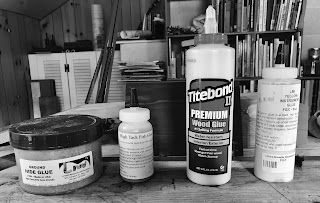The Glues That I Use
While the most visible features of a fine quality guitar are the materials and craftsmanship used in conjunction, another factor that contributes to quality are the adhesives used to hold it all together.
Jose Oribe, The Fine Guitar, 1985
I want everyone to know that I am not receiving any money from any of the glue manufacturers that I will talk about in this post. These are the glues I use when I make a classical guitar or on other shop projects.
Here are my go-to glues.
Titebond and Titebond II are PVA glues that I use for glueing the scarf joint on a guitar neck and the heel block to the neck shaft. Titebond sets quickly, has gap filling properties and when I do my part on making a good joint, the glue line is almost invisible. Fish and hide glues tend to absorb the water present in shellac and can become dark making the glue line more pronounced.
I also use Titebond to glue the joints for the tops and backs for the same reason. I don't want the glue line to stand out.
I can't say enough good things about fish glue. I usually purchase fish glue from Lee Valley which is a high quality glue that I like very much, however, the smallest bottle is 16oz. in size and it takes me almost two years to use an entire bottle.
I use this high tack glue to glue on binding strips and sometimes, if I am not in a hurry, I use it to glue the braces onto guitar backs.
This is the stuff!
Granular hide glue is simply amazing! It has a much and sometimes more shear strength that "modern" glues and dries glass hard, again, that is better fro energy transference.
I use hide glue where it really matters in guitar making - glueing the braces onto the top and back, the linings to the sides and glueing the back onto the guitar.
Every wood worker should try hide glue at least once on a project. Just make sure you have a heat gun handy to warm up all the parts that will be glue together.
Adhesives are what you make of them, each has their advantages and disadvantages, you need to experiment to find what works best for you and your projects.
Now, turn off your computer and get out into the shop!
Jose Oribe, The Fine Guitar, 1985
I want everyone to know that I am not receiving any money from any of the glue manufacturers that I will talk about in this post. These are the glues I use when I make a classical guitar or on other shop projects.
Here are my go-to glues.
Titebond and Titebond II are PVA glues that I use for glueing the scarf joint on a guitar neck and the heel block to the neck shaft. Titebond sets quickly, has gap filling properties and when I do my part on making a good joint, the glue line is almost invisible. Fish and hide glues tend to absorb the water present in shellac and can become dark making the glue line more pronounced.
I also use Titebond to glue the joints for the tops and backs for the same reason. I don't want the glue line to stand out.
I can't say enough good things about fish glue. I usually purchase fish glue from Lee Valley which is a high quality glue that I like very much, however, the smallest bottle is 16oz. in size and it takes me almost two years to use an entire bottle.
I use this high tack glue to glue on binding strips and sometimes, if I am not in a hurry, I use it to glue the braces onto guitar backs.
This is the stuff!
Granular hide glue is simply amazing! It has a much and sometimes more shear strength that "modern" glues and dries glass hard, again, that is better fro energy transference.
I use hide glue where it really matters in guitar making - glueing the braces onto the top and back, the linings to the sides and glueing the back onto the guitar.
Every wood worker should try hide glue at least once on a project. Just make sure you have a heat gun handy to warm up all the parts that will be glue together.
Adhesives are what you make of them, each has their advantages and disadvantages, you need to experiment to find what works best for you and your projects.
Now, turn off your computer and get out into the shop!






I use hide glue and the LMI yellow glue. Great stuff! In Winter when I worry about LMI glue possibly freezing during shipping I use that much more hide glue and/or Titebond. I haven't tried fish glue yet but I think you've convinced me to give it a try!
ReplyDeleteHi, Doug! Definitely give fish glue a try! Go to https://journeymansjournel.wordpress.com, he posted about fish glue and how he came to terms with it! Good luck!
ReplyDelete